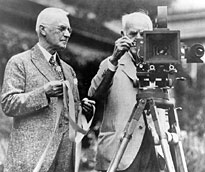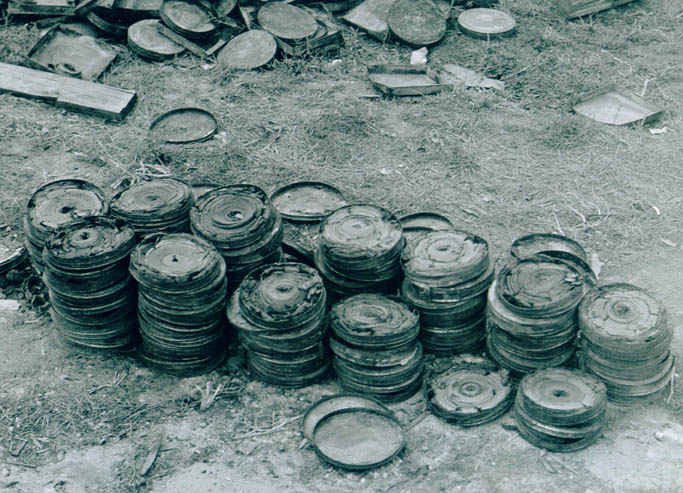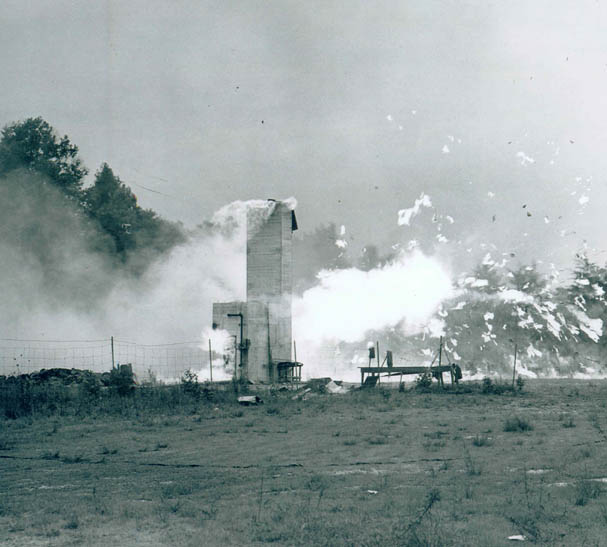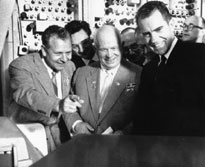
Chasing Technology
The Challenge of Preserving Audiovisual Records
Summer 2007, Vol. 39, No. 2
By Steve Greene
Archivists who work with audiovisual records often find themselves confronting a challenge their counterparts who deal with traditional paper records do not have. They must often act as "bucket brigades"—chasing one "fire" after another as rapidly changing technology threatens to render the media formats storing audiovisual records obsolete and inaccessible.
What these archivists face is the daunting task of preserving—and continuing to make accessible—records that offer an immediacy not possible with the written word. Moments of history captured in sound and pictures allow you to immerse yourself in a different place and a different time. Archival institutions across the country contain millions of hours of sound recordings, motion picture film, and video recordings.
The National Archives and Records Administration alone holds more than 360,000 reels of film, 275,000 sound recordings, and 110,000 items on videotape. Among them are large collections of newsreels, donated film collections, government-produced documentaries, and edited and unedited film from government and private sources as well as captured enemy film from World War II and the Korean and Vietnam wars. Unlike textual records, these documents require an investment of millions of dollars in equipment and trained personnel so researchers can access them fully.
Also unlike the written word, the technology behind these records changes quickly, and the archivists must constantly ensure that the still photographs, sound recordings, and moving images of American history are not trapped in obsolescent technologies. Like any American consumer, the archivist has seen audio recordings move from fragile phonograph records to iPods and visual records from brittle old film to digitally captured images.
Over the years, NARA has employed stop-gap measures, such as reformatting tape and film as technological changes force the agency's hand. But the increasing volume of audiovisual records and the rapid obsolescence of the technology that created many of them pose an even greater challenge for NARA and for all archives and archivists.
If NARA and other large archival institutions fail in this challenge, future generations will encounter a large gap in the understanding of the last 170 years. A system to preserve our audiovisual heritage must be open-ended and flexible enough for our successors to build on this framework. NARA's Electronic Records Archives is intended to be one part of the answer. ERA will be able to bring in any type of digital format and successfully preserve that record in its original condition, preserving its authenticity.
Where We've Been
The challenges of preserving audiovisual records—sound and moving pictures—began two centuries ago.
Humankind began creating imagery independent of the human hand at the beginning of the 19th century with early photographic processes such as the tintype and the daguerreotype.
As the technologies improved, the amount of photographic materials created began to increase. Toward the end of the 19th century, new technologies were applied to the mechanical capture of sound and moving images. These formats—photographic images captured on flexible plastic film and sound recordings mechanically captured on various media—continued in widespread use for almost 100 years.
Almost immediately these formats posed formidable preservation problems.
The plastic originally chosen as the base material for flexible photographic film was cellulose nitrate: a material that provided crystal-clear transparency for the silver-halide imagery stored on its surface. However, it also had the unfortunate habit of spontaneous combustion if stored in poor conditions.
The mechanical recording systems for sound had their own drawbacks. A material soft enough to be easily imprinted with grooves containing recorded sound was also soft enough to be degraded with each playback pass. Thus, the fidelity possible by stamping discs from a engraved master disc was limited at best.
Engineers quickly began to adapt, extend, and improve these technologies. Synchronized sound, and then color, was incorporated into moving image film. Cellulose acetate base "safety" film was developed to replace the dangerous nitrate material.
As is often the case with technical innovation, these improvements also carried preservation challenges. New materials and manufacturing techniques greatly improved the quality of recorded sound but failed to fundamentally address the limitations of mechanical recording. Acetate film, still widely used, suffers from its own chemical decomposition problem, in which the deteriorating film produces acetic acid, or vinegar. The dyes used in color films proved susceptible to fading.
Then, in the closing years of World War II, Allied intelligence analysts noticed an anomaly in the radio waves over bomb-ravaged Nazi Germany: lush, seemingly live symphonic performances being broadcast in a country where few concert halls were left standing by successive waves of Allied bombings. Not until after the war were prototype "Magnetophon" magnetic tape machines and reels of rust-coated paper tape discovered in the ruins of German radio studios.
The Magnetic Tape Revolution
After the war, engineers and entrepreneurs wasted no time in exploiting this new technology. By 1948 one of the most popular shows on radio, The Bing Crosby Show, was being recorded on magnetic tape. The advantages of the new format over disc recording were obvious, and its spread was viral.
By the end of the 1950s most radio programs were produced on reels of magnetic tape. As magnetic tape established itself in recording studios, various processes for recording moving images electronically (experimented with as far back as the 1930s) were dusted off and adapted to the new technologies.
The first prototype professional videotape recorders, using two-inch wide magnetic tape, were demonstrated at the National Association of Broadcasters Convention in April 1956. The advantages of this technology to the new medium of television were obvious. Magnetic videotape began to supplant motion picture film, first in the newsroom and later in entertainment programming.
Because the new media required fewer resources and less time, the amount of material captured by audio and video recording on magnetic tape began to increase exponentially. The volume of material was partially offset by the tendency of producers to erase and re-use tape as a budgetary measure. As videotape technology found its way into the home in the late 1970s, new markets for recorded video, and new industries to supply those markets, emerged.
The emergence of the consumer market for audio and video, combined with advances in electronics, drove the industry to adopt less expensive, smaller and denser formats. Analog open-reel magnetic audiotape was challenged first by the audiocassette in the consumer market.
In the professional sphere, technologies developed for the manned moon-landing missions during the 1960s and 1970s converted analog signals such as still photographs, sound, and moving images to the 0s and 1s of binary digital data. Digital magnetic tape formats supplanted analog open reel in the recording industry. These tapes allowed engineers in the 1980s and 1990s to capture up to two hours of high-quality digital sound to Digital Audio Tapes (DAT) that were less than half the size of the familiar audio cassette of the 1970s and 1980s.
This revolution in information density came at a high price. Analog open-reel tape had a demonstrated life span of at least 50 years under ideal conditions. The equipment to play back such recordings was relatively simple to fabricate. Contrast the lifespan of DAT recordings, which, using the most optimistic estimates, is likely less than 15 years. The complex integrated circuitry that made DAT possible would be difficult or impossible to replace or refabricate upon failure.
Because of the complexity of the mechanical and electronic systems of these recorders, minor mechanical faults in equipment or manufacturing defects in magnetic media could lead to a catastrophic loss of the recorded information on a tape.
Electronics had pushed the envelope of sonic fidelity and convenience past what was practical for magnetic tape technology. Digital optical disc technologies filled the void, first with Compact Disc Audio (CD) and later with the Digital Versatile Disc (DVD). A key feature of the devices that play these media are digital-to-analog converters, essentially miniature computers dedicated to converting binary digital data to analog audio or video signals.
By the mid 1990s, personal computer processing, storage capacity, and memory technologies had advanced to the point that production processes that had previously been done by laboriously hand-splicing magnetic audiotape could now be accomplished in real time on the computer via various electronic editing programs. These editing programs had the added benefit of being "nonlinear," meaning segments of recorded sound could be moved, removed, or replaced without requiring real-time playback of the source and master. Additionally, the new nonlinear editing processes were nondestructive—media was not physically cut or recorded over to achieve the desired editing effects. As personal computer processing power continued to increase, this technology was applied to moving image production.
One effect is that vast quantities of motion picture film commonly used in the traditional cut-and-splice editing process are no longer required. Film products designed to monitor the status of ongoing productions such as daily "rushes" (prints of a previous days filming), check prints (prints designed to check the success of a film effect), and answer prints (the first print from an edited negative) became a thing of the past. Film manufacturers began to sell less stock, and profit margins declined, accelerating the adoption of digital moving image technologies.
With the rapid fading of magnetic tape in audio and video production work and the approaching obsolesence of motion picture film, not only are audiovisual archivists faced with an ever-increasing tide of new records that were "born digital," but the tools and processes they relied on to preserve "traditional" analog audiovisual media are rapidly disappearing.
The traditional formats and the magnetic media that supplanted them from the 1960s to the 1980s had many differences, but they were all essentially carriers of information. As that information began to be encoded and reproduced digitally, suddenly it seemed they were no longer so formidable. Once there was an imposing backlog of unprocessed and unpreserved audiovisual records. The sheer volume of the records—millions of feet of film, thousands of hours of audio, thousands more of video, and millions of still photographs—was complicated by a morass of obsolete technology, with different processes, different formats, and different handling requirements.
Before the advent of digital storage, each succeeding level of technical innovation in audiovisual production was accomplished at the cost of increasing electronic and mechanical complexity and decreasing backwards compatibility to earlier formats.
The inherent cost of reformatting existing records to newer media was partially offset by the newer technology's ease of use, which resulted in an exponential increase in the creation of new audiovisual records. The costs to libraries and archives of keeping up with the new technology and new records, on the one hand, and maintaining the old technology to support the ability to reformat existing records, on the other hand, rapidly became unsustainable.
Digitization seemed to promise "the Answer." Suddenly all these records could be seen as just data . . . and we knew data. Government and corporations have had information technology (IT) offices for years, as far back as the 1950s. Suddenly it seemed manageable: hard disks, tape backups, network servers. We were old hands at this technology, or so we thought. Data storage on magnetic tape and hard disk drives dates back to the late 1950s and early 1960s in corporate and government data centers. Networking technologies emerged first in universities and government research centers in the 1970s.
This is why, on the surface, the ability to store moving images, sound, and still pictures as data files on computer hard drives appears so attractive. Technologies created to keep computer servers running with a minimum of intervention have been re-tasked to house digital photographs, audio files, or digital video.
These data storage systems (RAID, for Redundant Array of Independent Disks) have built-in data-redundancies (critical data is duplicated in different parts of the array), which limit the risks inherent in storing valuable data in a single hard disk. They also typically have faster read and write access times and greater data/second "bandwidth" than individual hard disks. The drawback is that the storage and bandwidth requirements for uncompressed still pictures, digital sound, and moving images dwarf those of conventional business data.
One informal unit of measurement of digital storage is the "loc" or the estimated equivalent of the entire holdings of the Library of Congress digitized as simple text files, commonly thought to be around 20 terabytes (1012 bytes, or roughly one trillion bytes) of data.
By comparison, a single feature film digitized for storage at the highest practical uncompressed data rate—"4K" resolution (a scan of about 4096 picture elements [pixels] on the long axis of the image)—can take up to eight terabytes of data for a finished motion picture film production, as released.
If we include for consideration all the associated data files generated for editing or special effects, we can bump that total up to as much as 400 terabytes. While films scanned at this high resolution capture most of the detail available in modern color motion picture stocks, the high costs associated with maintaining a system capable of managing these storage and throughput requirements currently places such a system out of reach for most public archives and research facilities.
Re-Defining the Task
Clearly, the goal of capturing every second of moving image or sound and every still picture in the immense holdings of NARA as uncompressed data at a comparable digital resolution to the original media is out of reach using current technology. Given the continued exponential growth in the creation of new audiovisual records, this goal may continue to elude NARA for years. So what are some alternatives for preserving both our existing analog multimedia heritage and the vast amount of new "born digital" data being generated?
- Lower capture resolutions. For motion picture film and still photo image capture, significant reductions in storage and throughput requirements could be achieved by scanning at lower resolutions. A "2K" scan (about 2048 pixels on the long axis of the image) requires about one-quarter the storage and throughput capacity of the "4K" scans. The lower resolution may not capture all the detail available in the original film. Similar savings could be made in digitizing recorded sound by lowering the rate at which analog audio signals are sampled by analog-to-digital converters.
- Compression. Even more radical space and throughput savings can be achieved through the use of digital compression algorithms. Most compression schemes try to achieve these savings in areas where the human eye is unlikely to perceive detail or in areas with static scenes or large blocks of solid colors. Compression, however, adds an additional layer of complexity and a risk of failure to decode and reproduce the moving image, sound, or still photographs.
- Triage, sampling, and de-accessioning. Archivists can reappraise existing records, identifying those at greatest risk and those most likely to have significant research demands. Realizing that it may never be possible to completely preserve the full range of existing and incoming audiovisual records, an institution could use statistical sampling to retain the most complete picture of the broad range of records.
Managing the Future
Eventually, preservation reformatting that has been the domain of traditional analog processes will be done exclusively in the digital domain. The large volume of existing records and the influx of new digital audiovisual records add urgency to the quest for sound digital acquisition and storage procedures.
Audiovisual preservation systems on large multiple hard disk arrays will continue to be used to house existing and newly created audiovisual records. These systems will require an interdisciplinary effort among those responsible for creating new records, archivists, audio-video preservation specialists, and information technology specialists to create an open-ended, flexible storage and preservation system that can survive, adapt, and grow as storage technology reinvents itself. Such a system must automate the process of regularly refreshing and verifying digital data.
Digital Asset Management, a relatively new software category, will become the key tool of the audiovisual archivist. At once a database, finding aid, and a reference tool, it offers the promise of maintaining and expanding intellectual control over audiovisual records in the digital age.
NARA is addressing the need for preservation of and permanent access to electronic records through its Electronic Records Archives system. The goal of ERA is to ensure that the electronic records researchers obtain from the National Archives next year, in five years, or at any time in the future, are not corrupted or distorted by changes in technology.
But will ERA be able to handle audiovisual records in digital formats on its first day of use?
No. ERA will begin its initial operating capacity, expected in late 2007 or early 2008, modestly, taking in only electronic records from four federal agencies. Although six types of records formats will be ingested in ERA, audiovisual records are not included in the initial transfer from the four agencies.
The true difficulty is not with preserving the record but rather with ensuring that the record is accessible over the long term. Initially, records submitted to ERA will be accessible through the software that was used to create the record. Over time, strategies and technologies for ensuring the continued accessibility to these records will be developed, tested, and implemented. While specific policies are still under development, the expectation is that records with high public interest will be addressed first, while other formats will wait for resources to become available.
Regardless of the technologies and strategies employed with the ERA, the next few years will be a time of continuing and accelerating change for those of us on the NARA staff charged with preserving audiovisual records. Traditional analog audiovisual records will not be going away immediately. The skills that audiovisual archivists have developed over decades will continue to be needed but must grow to include the new technologies. This means serving as an advocate for the records and as an intermediary between records creators, IT professionals, and our researchers.
Our ability to reinvent the profession of audiovisual archivist will determine how well we meet the many challenges inherent in managing the transition from "traditional" audiovisual records into the new digital era.
Steve Greene is a senior archivist with the Nixon Presidential Materials Staff at the National Archives at College Park. He has worked on the preservation, archival processing, and reference service on this unique body of audiovisual records since 1987.



